By Peter Collins
I had not flown the Pilatus PC-12 or -12 NG single turboprop; received no simulator training or computer-based training on the upgraded aircraft's Honeywell Primus Apex avionics and had never seen the cockpit of the PC-12 NG up to the moment of the pre-flight briefing just before engine start.
So when Flight International was given one of the first opportunities to evaluate the PC-12 NG, the level of success with which I could manage the aircraft was bound to be a direct indicator of the quality of the avionics upgrade in particular and the aircraft's suitability in general.
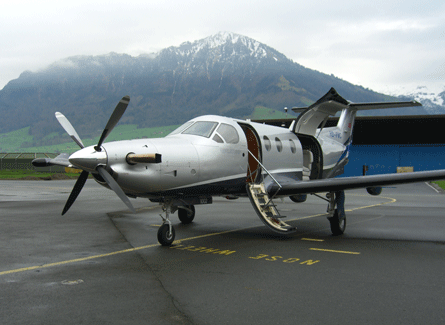
The successful PC-12 first flew as a prototype in May 1991 and was certificated in the FAA/JAR Part 23 commuter aircraft category in 1994. After 788 deliveries, the Swiss manufacturer has given the PC-12 a major avionics, cockpit and systems upgrade and renamed it the PC-12 NG (Next Generation).
TEST EFFORT
Pilatus expended a considerable test effort in the upgrade development. The NG certification programme began in October 2006 using three test aircraft that flew 364 test sorties and clocked 669 flight test hours. Joint US Federal Aviation Administration and European Safety Aviation Agency certification were gained this year, on the same day - 28 March.
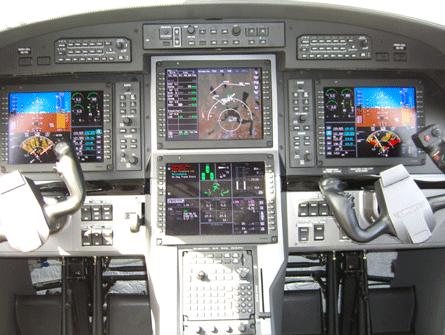 |
|---|
The Honeywell Primus Apex avionics system is at the heart of the upgrade |
All new PC-12s will now be produced to the NG standard. The orderbook for the aircraft already stands at more than 200, while Pilatus is building new facilities at its airfield site near Stans in Switzerland and plans to ramp up the PC-12 NG production rate from 100 to 125 a year over the next two years.
At the heart of the upgrade is the Apex electronic flight information system developed for Pilatus from the Epic system and similar in digital architecture to that of the Dassault Falcon EASy.
The four display screens are identical, with a 10in (255mm) diagonal size and set in the cockpit in a "T"-shape layout. The pilot flying displays are set left and right (the right display is optional) with the two multifunction displays (MFD) in the centre - although these can be switched to above or below.
Each display screen can be subdivided into 1/6, 1/3 or 2/3 internally boxed sections to show various groups of data. Below the bottom MFD and forward of the power lever is the multifunction controller, which is used to control the "focus" of any of subsections on any of the four main screens and then enter data into the PFDs/MFDs using the alphanumeric buttons or a small joystick on the multifunction controller front face.
SYSTEMS SUPPORTED
Among the systems supported by Apex are traffic alert and collision and avoidance terrain awareness warning JeppView electronic flight charts crew alerting electronic moving map lateral navigation (LNAV) vertical navigation (VNAV and only advisory at present) and all engine and aircraft data.
Outboard of the left pilot flying display is the electronic standby instrument system (ESIS), which can use its own emergency power system (battery) in the event of a total electrical failure. The complete cockpit and all displays are now completely digital in function and connection and there are no associated analogue instruments or display panels.
The engine has been uprated to the more powerful Pratt & Whitney Canada PT6A-67P and flat rated at 1,200shp (895kW) for take-off and climb up to an outside air temperature of 33°C (91°F). Time between overhaul is 3,500h. VMO/MMO of the PC-12 NG is 236kt (436km/h)/Mach 0.48. A maximum level cruise of 280kt is achieved at 20,000ft (6,100m).
Electrical power has been increased to two engine-driven generators each delivering 28V/300A and two 24V/42Ah batteries. In the event of generator failure, load shedding has been designed to be automatic to reduce single pilot workload - an enhancement in my view.
Passenger comfort has been improved by a digitally controlled aircraft pressurisation and cabin environmental control system. The pressurisation schedule is fully automatic and linked to the flight management system (FMS) navigation computer of Apex.
ROLL CONTROL
Roll control forces have been improved by new aileron servo-tabs and the yaw damper features an auto-rudder trim function (with yaw damper engaged) to counteract propeller torque effects without the need for pilot rudder input.
I flew three separate sorties in rapid succession, from Buochs to Grenchen (LSZG), Grenchen to Zurich (LSZH) and Zurich to Emmen (LSME) to overshoot and land back at Buochs.
These flights were accomplished through complex and busy airspace, into airports varying from austere to international, with widely different runway sizes and using a wide variety of approach aids, visual circuits and approach angles.
The sorties were flown manually and auto-pilot coupled, with go-arounds, normal landings, short landings, full stops and complete aircraft shutdowns at the end of each leg.
I flew all the sorties myself in the single pilot role. Michael Alb, my Pilatus safety pilot, only assisted me with the radio telephony, given my unfamiliarity with the local Swiss airspace.
On entering the cockpit, my first and strong impression was of how modern, well made, well laid out and uncluttered the Apex system made the whole cockpit feel.
All switches used during normal flight are forward of the power lever quadrant. The power lever combined the functions of throttle and prop RPM in a single lever so, additionally, the simplicity of the whole power quadrant added to the uncluttered cockpit impression.
I liked the grouping of the ice protection switches behind the left-hand pilot yoke and the design of the rocker switches, which made individual selection quick and simple.
Below the glare shield, well shaded and directly in front of the pilot was the communications control panel and centrally mounted was the autopilot control panel (ACP).
Both these panels featured small green indicator lights next to the selected button, which made nav/comm audio channel or ACP mode selections easy to confirm with just a glance.
This is in stark contrast to other systems that feature just "dumb" buttons on a black panel background and where incorrect ACP mode selections are easy to make, especially when the workload is high.
'DARK COCKPIT' PHILOSOPHY
The small overhead panel was principally to control the electrical system plus engine start, stall warning shaker/pusher test and external lights. Apart from turning the taxi/landing lights on or off pre-take off/post landing, there was no need for the pilot to use or check the overhead panel in normal flight. Apex keeps to a "dark cockpit" philosophy.
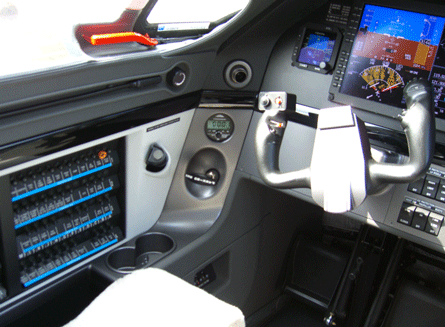 |
|---|
The Apex system makes for a modern, well laid-out, uncluttered cockpit |
Pilatus has designed a standby electrical function, fed from one of the batteries, to supply just the lower navigation MFD screen with power for FMS programming pre-start without the risk of battery drain and without the need for external power, an auxiliary power unit or a running engine.
This means that the pilot can programme the FMS before the passengers arrive and so dramatically reduce his/her later workload. I found this function to be a real advantage.
Programming the Apex through the various phases of initialisation, take-off, cruise and approach was delightfully simple and logical.
The different flight phases are displayed as symbols and all data input is done "up front" without the usual multiple and hidden pages used in a conventional FMS where the input is required via a computer display unit.
As one data box in the lower MFD was filled and entered, the Apex system automatically jumped to the next. The FMS navigation route overlaid the waypoints on an electronic "real world" MFD map that showed terrain, lakes, airspace boundaries, and so on, and has the potential to show additional details like cities and roads if required.
The navigation MFD gave me a wonderful sense of situational awareness. I also liked the function of the joystick on the MFP to drive a cursor on the navigation MFD.
Post-start, with all screens illuminated, it is normal that the navigation MFD is switched to the top centre and the aircraft systems MFD selected to the bottom centre.
My first FMS programming (Buochs to Grenchen) took no more than 10min to complete pre-start, but later in the day the other sorties took no more than 3-5min to prepare and to insert all the route data as I quickly became familiar with Apex.
The before engine-start checks took just seconds to complete and consisted essentially of turning the batteries and fuel pumps on and pressing the engine-start button (there are no first-flight-of-day checks and most other test functions are automated).
Light up was instant, the condition lever was placed to ground idle, the flaps set to 15° and the stall warning system tested - and that was it.
We were ready to taxi, with after-start and before-taxi checks complete, fully configured and fully programmed, less than 60s after pushing the engine-start button. On other turboprops, first-flight-of-day checks can take over 60min to complete.
Before take-off, the condition lever was set to flight idle, but the Apex configuration warning also ensures no miss trim or miss flap settings - an advanced feature for this class of aircraft. Weight at take-off was 4,100kg (9,000lb) - 3,000kg basic, 250kg crew plus cargo and 850kg fuel. Maximum take-off weight for the PC-12 NG is 4,745kg.
 |
|---|
The PC-12's wingtip weather radar remains part of the aircraft's standard fit |
Outside air temperature was 13°C and QNH 1,024hp. At brake release the power lever was simply placed fully forward to the stop, the torque limiter automatically protecting the pilot (since I slammed the power lever forward like a jet) and with no torque overswing observed throughout any of the sorties.
BRISK ACCELERATION
Take-off acceleration was brisk and the aircraft leapt into the air at the rotate speed of 85kt. After settling at the climb speed of 140kt, the initial climb rate was over 3,000ft/min (15.25m/s). LNAV was followed with autopilot coupled and a GPS overlay VOR/DME approach flown at Grenchen using vertical speed to follow an advisory VNAV profile.
I believe the ACP would benefit from a vertical speed "wheel" and a speed select knob allied to a displayed blue speed bug on the PFD vertical speed tape. Pilatus says it is considering this.
However, to keep things in perspective, I had just successfully completed, unaided as a single pilot, an advanced GPS/non-precision approach at an airfield I had never seen before, in an aircraft I had never flown before just 15min after my first take-off.
A go-around was then conducted at Grenchen to circle for Runway 07 visual circuits. The manoeuvre was simple and stress-free to accomplish by just pushing the go-around button in the power lever handle (the autopilot remains engaged and the go-around required pitch is automatically set), pushing the power lever forward to the stop, setting flap to 15, taking gear up and re-engaging LNAV.
Returning to the visual flight rules circuit and flying manually showed the aircraft to have fine mechanical control characteristics and the aileron servo-tabs seemed to have completely cured the earlier reported problems of heavy lateral control noted in the original PC-12s.
The landings at Grenchen showed the aircraft was in its element landing on a runway only 23m wide and stopping with "passenger comfort" within 500m from a VREF speed of 85kt.
On my second sortie I flew a high-speed instrument landing system approach (200kt initially, but reducing to 180kt due to ATC constraints) manually at Zurich Runway 14, slowing at around 5km (3nm) to configure and land with 15° flap at a VREF of 100kt.
On all these approaches I very much appreciated the layout of the Apex PFD, which groups flight, compass, TAWS, engine and navigation/communication information on one screen. It again reduced my workload by centralising information critical to the single pilot.
RETURN LANDINGS
For my return landings at Bouchs, after go-around at Emmen, Alb first demonstrated and I then flew a steep approach circuit, starting the finals turn from a 5,000ft downwind leg. The flaps at their full 40° setting and the prop in flight idle gave outstanding drag and speed stability to hold around an 8° approach angle and, with a pre-flare at around 100ft, the aircraft could be touched "on the numbers" at VREF with great accuracy. My final landing was a short landing from a normal circuit, touching at around 70kt and requiring no more than 350m of runway length.
On shutdown we had flown three complete sorties, with multiple approaches, circuits and go-arounds, a flight time of 1h 30min and we had used just 445kg of fuel.
The aircraft, with the new aileron servo-tab system, was light and responsive in all axes and a real joy to fly manually. The PC-12 NG's handling characteristics closely resembled those of the much smaller EADS Socata TBM 850. It was as easy to manoeuvre the PC-12 NG aggressively around a tight or steep approach visual circuit as it was to accurately track the guidance needles of the flight director on an ILS with the autopilot disengaged.
The increased power of the -67P allied to the torque limiter, single power lever, auto rudder trim and the almost instant power "bite" of the prop meant that the aircraft felt and handled like a jet, but with none of the jet engine "lag" when accelerating up from idle.
The power brake effect of the prop on landing was outstandingly effective allowing for very short landings without the need for virtually any wheel brakes during the landing roll and with none of the complications of lift dump, auto-brake or thrust reversers many jets require.
Additionally, the risk of foreign-object damage is greatly reduced with the intake inertial separator engaged, compared with the open intakes of similar size jets and especially when operating from austere, semi-prepared or unswept tarmac strips.
The PC-12 NG gave me the impression that it could safely and easily fly, with a single pilot, into or out of any sort of short strip of as little as 500m in length, surrounded by any sort of terrain, through some of the most congested and complex ATC environments, into any international airport, in a variety of configurations, on multiple sectors every day for the next 15 years and never miss a heartbeat.
With the ever-increasing price of oil and the recent resurgence of turboprops in the airliner market, it shows that turboprops can hold their own with jets in everything apart from ultimate top speed (if range considerations allows it) and ultimate cruise altitude (if ATC allows it), but cost their owners far less to run.
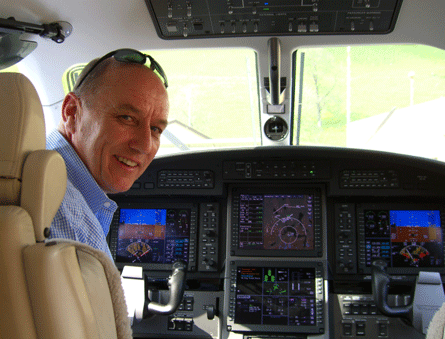 |
|---|
Peter Collins: "I had never seen the PC-12 NG cockpit up to the moment of the pre-flight briefing |
The PC-12 NG's combination of lower purchase price (Pilatus says it is about $1 million less to buy than the Beechcraft King Air B200 GT to a similar specification) and with up to 40% less direct operation costs than its nearest twin-engined turboprop competitor of similar size means that, in my view, the PC-12 NG has no real commercial competitor.
Any comparison with a jet of a similar size is meaningless because it becomes an "apples and oranges" argument between outright performance, capability and direct operating costs. Undoubtedly, the PC-12 NG will be as popular with the company chief financial officer to fund as it will be with the chief pilot to operate and the company executives to travel.
The avionics upgrade is by far the best upgrade to a presently certificated civil aircraft that I had ever had the good fortune of evaluating. With the Apex allied to the other aircraft upgrades of cockpit controls, engine power, electrical system, aileron servo-tab, pressurisation controller, and so on, it meant that the PC-12 NG truly felt like a new aeroplane rather than just an upgraded one.
The Apex is similar in functionality and display to the EASy cockpit. Apex is very intuitive, outstandingly easy to programme/manage and has a much better human vehicle interface than that presently offered by the older style electronic flight information system using a separate FMS, radio management unit and single-mode display screens.
Single pilot operation will always have some high workload areas, but the Apex system will be a massive workload reducer and safety provider.
CONCLUSIONS
I left Stans hugely impressed. I believe that, with this NG upgrade, Pilatus has raised the bar in this class of commuter aircraft.
Overall, I found that the PC-12 NG had a "look right, feel right, fly right" type of aura and was stacked with good design from nose to tail for pilot and passenger. I found it so good in all of the assessed areas of flyability, useability and affordability.
When the long-overdue EASA regulations governing single-engine IFR commercial operations are agreed and the survivability aspects can be properly addressed by all owners/operators from an internationally defined position, I believe the PC-12 NG has the potential to become a world beater.
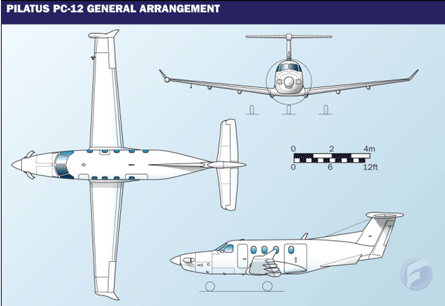 |
|---|
Source: Flight International























